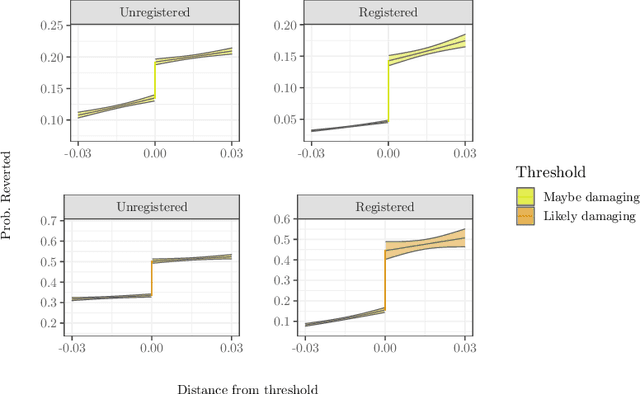Nathan TeBlunthuis
Misclassification in Automated Content Analysis Causes Bias in Regression. Can We Fix It? Yes We Can!
Jul 12, 2023Abstract:Automated classifiers (ACs), often built via supervised machine learning (SML), can categorize large, statistically powerful samples of data ranging from text to images and video, and have become widely popular measurement devices in communication science and related fields. Despite this popularity, even highly accurate classifiers make errors that cause misclassification bias and misleading results in downstream analyses-unless such analyses account for these errors. As we show in a systematic literature review of SML applications, communication scholars largely ignore misclassification bias. In principle, existing statistical methods can use "gold standard" validation data, such as that created by human annotators, to correct misclassification bias and produce consistent estimates. We introduce and test such methods, including a new method we design and implement in the R package misclassificationmodels, via Monte Carlo simulations designed to reveal each method's limitations, which we also release. Based on our results, we recommend our new error correction method as it is versatile and efficient. In sum, automated classifiers, even those below common accuracy standards or making systematic misclassifications, can be useful for measurement with careful study design and appropriate error correction methods.
Measuring Wikipedia Article Quality in One Dimension by Extending ORES with Ordinal Regression
Aug 31, 2021



Abstract:Organizing complex peer production projects and advancing scientific knowledge of open collaboration each depend on the ability to measure quality. Article quality ratings on English language Wikipedia have been widely used by both Wikipedia community members and academic researchers for purposes like tracking knowledge gaps and studying how political polarization shapes collaboration. Even so, measuring quality presents many methodological challenges. The most widely used systems use labels on discrete ordinal scales when assessing quality, but such labels can be inconvenient for statistics and machine learning. Prior work handles this by assuming that different levels of quality are "evenly spaced" from one another. This assumption runs counter to intuitions about the relative degrees of effort needed to raise Wikipedia encyclopedia articles to different quality levels. Furthermore, models from prior work are fit to datasets that oversample high-quality articles. This limits their accuracy for representative samples of articles or revisions. I describe a technique extending the Wikimedia Foundations' ORES article quality model to address these limitations. My method uses weighted ordinal regression models to construct one-dimensional continuous measures of quality. While scores from my technique and from prior approaches are correlated, my approach improves accuracy for research datasets and provides evidence that the "evenly spaced" assumption is unfounded in practice on English Wikipedia. I conclude with recommendations for using quality scores in future research and include the full code, data, and models.
The effects of algorithmic flagging on fairness: quasi-experimental evidence from Wikipedia
Jun 04, 2020



Abstract:Online community moderators often rely on social signals like whether or not a user has an account or a profile page as clues that users are likely to cause problems. Reliance on these clues may lead to "over-profiling" bias when moderators focus on these signals but overlook misbehavior by others. We propose that algorithmic flagging systems deployed to improve efficiency of moderation work can also make moderation actions more fair to these users by reducing reliance on social signals and making norm violations by everyone else more visible. We analyze moderator behavior in Wikipedia as mediated by a system called RCFilters that displays social signals and algorithmic flags and to estimate the causal effect of being flagged on moderator actions. We show that algorithmically flagged edits are reverted more often, especially edits by established editors with positive social signals, and that flagging decreases the likelihood that moderation actions will be undone. Our results suggest that algorithmic flagging systems can lead to increased fairness but that the relationship is complex and contingent.
 Add to Chrome
Add to Chrome Add to Firefox
Add to Firefox Add to Edge
Add to Edge